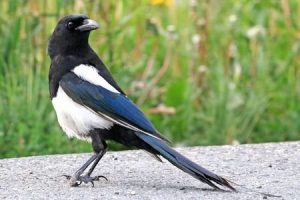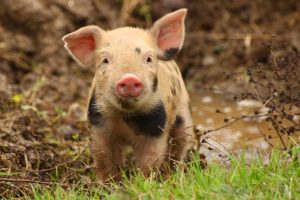
Dumb Animals?
Animals are amazing, and these true stories prove they are not so dumb as some people make out
Bravery in humans is regarded as one of the most noble things a man or woman can accomplish. Our history books are full of the brave deeds that people have done to make our present life possible. Yet our history books seldom tell us that nature has heroes too!
The Caring Crane
A crane, having caught an especially large fish in one of Florida’s lakes, carried it out of the water. He gracefully walked up the bank away from the lake, and settled himself some forty feet from the edge. Cranes, like many other birds, do not chew their food, they simply swallow it whole. But the crane’s eyes had been too big for its swallow so to speak. Try as it might, the fish was too big, and it couldn’t swallow it So after several unsuccessful attempts, it dropped the fish and walked away.
After walking some sixty feet from its catch however, it stopped, looked back, and then returned to the fish. Receiving a quick peck the fish tried to flop away. The crane, on seeing it was still alive, picked it up in its bill, and carried it all the way back to the lake. It dropped it into the shallows, and then pushed it out into the deeper water-to safety!
It would be difficult to call that crane a “dumb animal” in the sense of it being unintelligent. One could hardly call its action instinct either. Rather, it is the sort of action one would associate with an intelligent human.
In recent years, scientists have begun to believe that wherever there is life, there is some sort of intelligence. The more we study animals the more one is convinced that this is true.
Ants Raise Mushrooms and have Chemical Warfare
Did you know, for instance, that ants can do many of the things that men can do? They raise mushrooms, have slaves to wait on them, have a form of chemical warfare, weave, keep small flies-aphids which they milk like cows, and they work as we do, probably harder. Unlike the action of the crane how-ever, this can all be called instinct.
Ants use a variety of cues to navigate, such as sun position, polarised light patterns, visual panoramas, gradient of odours, wind direction, slope, ground texture, step-counting … and more. Indeed, the list of cues ants can utilise for navigation is probably greater than for humans.
Ants use a variety of cues to navigate, such as sun position, polarised light patterns, visual panoramas, gradient of odours, wind direction, slope, ground texture, step-counting … and more. Indeed, the list of cues ants can utilise for navigation is probably greater than for humans.
Animal Instincts
Instinct, you see, is something an animal or man does without having to think about it. For instance, animals, without having to he taught, know which food is good for them that is instinct. Ants, since the dawn of time, have been doing just as they do today. Intelligence, however, is the ability to solve an unusual problem that is uncommon to the particular animal.
In the province of Ontario, Canada, there is a large game reserve called Algonquin Park. Within the boundaries of the park it is not permitted to kill animals. In Canada the deer hunting season begins in late autumn. For some years, it has been noticed that every November, large numbers of deer move into the protection of Algonquin Park. How do you suppose the deer knew where they were safe?
The Digger Wasp Innovator
A famous zoologist tells how a digger wasp amazed him with its intelligence. He had been walking by a small river, when he noticed the wasp. It had stung and paralysed an enormous spider. Digger wasps bury such food with their eggs, so that when they hatch, the grubs will have food to eat. The wasp was trying very hard to drag the spider back to its burrow. The load was too heavy to fly with, and as there were so many barriers even dragging was impossible. The wasp wasn’t beaten however. Deciding on a new course of action he managed to pull the spider down to the river. Here, taking a firm hold, the wasp floated its kill out onto the stream. With wings buzzing at top speed, it slowly manoeuvred its strange craft seventy yards down the stream. Then, pulling the spider ashore, it dragged it the remaining few inches to its burrow.
Instinct or intelligence? To the zoologist it was an unforgettable experience. Even insects “have their Columbuses and Galileos,” he said.
The Heroic Wolf
Mr. Lyman Jackes was out with the ranger of a large national park in America, when they noticed a number of deer frantically running. Climbing a small hill they saw the reason. Across a nearby swamp, eleven wolves were carefully making their way over the treacherous footing. As part of the ranger’s work was to keep the wolf population down to a suitable number, he took careful aim with his rifle, and fired the only five bullets he had with him. One by one, five wolves fell as he shot, the others retracing their steps as fast as possible. Both men picked up a stout piece of wood to act as a club, and began to descend the hill to examine their kill. As they did so, however, a large she wolf, somehow sensing that they were out of ammunition, came toward them snarling and showing her fangs. At twenty feet from them she stopped, but continued her menacing snarls. Mr. Jackes and the ranger raised their clubs and tried to advance, but the wolf held her ground as much as she dared, effectively barring their way to the swamp.
For half an hour the she wolf stood her ground against them, and then suddenly, without warning, turned and ran as quickly as possible across the floating islands of the swamp. After the delay, search as they might, the two men could find no other trace of the shot wolves than here and there a few spots of blood.
Was that instinct, to so quickly realise that given time the wounded wolves could drag themselves away and hide? If it had been a human, it would have been called “quick thinking,” and an “act of bravery and intelligence.” I for one am sure it was with the she wolf, too.
Pigs are Smart Too
Most people just think of pigs are bacon sources, but new research shows we really need to rethink our relationships with these portly animals. Pigs are some of the smartest creatures on Earth, with intelligence on par with chimpanzees, dogs, and even 3-year-old children.
The of results of research were surprising. Pigs form relationships just like we do, with a society focused around the relationships between parents and offspring. Pigs recognize other pigs as individuals, can understand symbolic language, have amazing long-term memories, and form close bonds with familiar humans.
Probably the most human-like trait they have developed is that, like countless teenagers, pigs love wasting their time playing video games. Researchers have developed games for pigs that let them move color lights to targets on touch screens. They will even play the game against a human player and do better than dogs do at comparable games. It’s only a matter of time before they learn Call of Duty, so maybe it’s time to rethink pigs.
The Future
In millions of years, when humans have destroyed themselves or moved on to another planet, it will be up to animals to take over the Earth. But never mind the distant future: some animals alive now have already developed intelligence that rivals our own. They’ll probably be the next sentient race.
Whales and dolphins are known as cetaceans, which means “big fish” in Latin, even though they aren’t fish. Bravely triumphing over this horrible misnomer, cetaceans have evolved into amazing creatures that are super smart. But their intelligence isn’t just doing cool tricks. They have made their own pictorial language.
Cetaceans produce sound to find out how far away things are, like sonar. It’s a skill not just used for navigation but also as a language completely unlike our own. Cetaceans can learn the shape of a creature or object and then project that sound profile to other members of their species. For example, a dolphin can learn what image a fish makes when they bounce sound off of it. Then, if the dolphin wants to tell another dolphin that it saw a super rad-looking fish that it just has to tell a friend about, it can project that sound profile to its dolphin buddy.
It works really well, and cetaceans have developed complex social structures using communication. Researchers are still trying to figure out how complex cetacean language is, but we probably aren’t too far off from them figuring out how to talk to us and tell us, “So long, and thanks for all the fish.”
Elephants mourn their dead
Nature doesn’t care about emotions. We watch lions just tearing up gazelles willy-nilly and animals just leaving their dead to rot. But a few animals have developed at least a little bit of feeling (or a lot of feelings, as we are reminded whenever we are around moody teenagers). Shockingly, elephants have led the charge on this, mourning for their dead and even holding funeral practices.
Researchers have long suspected that elephants do this but find it nearly impossible to get any video footage of it. Elephant funerals are really exclusive affairs evidently, and they aren’t fans of humans showing up to film. Frankly, after all the poaching, we wouldn’t trust humans either if we were elephants. However, really sneaky researchers have watched elephants bury their dead under foliage. Researchers have even discovered elephant cemeteries. Some elephant families go through the effort of burying all their dead in the same place.
We also know that when a member of their family dies, elephants become more stressed and depressed. How they developed a respect for the dead is still a mystery, but it’s a fascinating example of how animals can feel in ways similar to humans. Knowing that, it makes the ivory trade even sadder.
Octopi are surprisingly mischievous
If we had to make a list of animals that were the most different from humans, octopi would find themselves pretty close to the top. They’re super weird-looking and have evolved in totally different ways from humans, but they’re one of the few creatures that has near-human intelligence. Researchers have observed octopi doing really intelligent things like showing self-awareness, complex defensive strategies for their homes, and being really stingy with their friend groups. Those are impressive, but what freaks us out is that they use their big brains to troll their human counterparts.
In Germany, an octopus named Otto got sick of the lights above its aquarium. Wanting to do some redecorating, Otto shot water at the lights, knocking them out one by one. The aquarium staff had trained him to shoot waters at guests, and Otto turned that skill back around to destroy lights and cause mayhem for the staff. Across the ocean in California, another octopus figured out how to dismantle the plumbing in his tank and flooded a whole aquarium, just because he could. With this sort of mayhem, Cthulhu is probably very proud.
Eurasian Magpies are Self-Aware
Self-awareness is a trait only a few animals have. Most animals, when shown a reflection of themselves in a mirror, don’t realize the reflection is themselves but think it’s an anim al of the same species. Hilariously, sometimes, animals like parrots will befriend their own reflections. Only the smartest animals can identify a reflection of themselves as themselves. Only one bird can. As smart as crows and parrots are, that achievement belongs to the Eurasian magpie.
al of the same species. Hilariously, sometimes, animals like parrots will befriend their own reflections. Only the smartest animals can identify a reflection of themselves as themselves. Only one bird can. As smart as crows and parrots are, that achievement belongs to the Eurasian magpie.
To test magpie self-awareness, researchers stuck little stickers on the magpie and put them it in front of a mirror. As soon as they did, the magpie got super agitated and started trying to pull off the sticker, probably because it was a color that didn’t match its eyes or something. Oddly, the magpie didn’t mind the feeling of having the sticker on its neck, it just freaked out when it saw the sticker in the reflection.
What is really weird about the results is that for years, biologists have thought that self-awareness resides in the part of the brain called the neocortex. But birds don’t have one. Magpies aren’t really animals that people pay too much attention to, but it turns out they’re a big mystery for animal researchers.
I believe that intelligence is in every living thing – for we are all creatures of the amazing and miraculous universe.


Comments
Tony – I enjoyed reading your stories. They reminded me of something about ants I had stumbled upon online years ago. I was able to trace it again, for I had written it down:
In nature, hypercommunication has been successfully applied for millions of years. The organized flow of life in insect states proves this dramatically. Modern man knows it only on a much more subtle level as “intuition.” But we, too, can regain full use of it. An example from Nature:
When a queen ant is spatially separated from her colony, building still continues fervently and according to plan. If the queen is killed, however, all work in the colony stops. No ant knows what to do. Apparently the queen sends the “building plans” also from far away via the group consciousness of her subjects. She can be as far away as she wants, as long as she is alive.
In man hypercommunication is most often encountered when one suddenly gains access to information that is outside one’s knowledge base. Such hypercommunication is then experienced as inspiration or intuition. The Italian composer Giuseppe Tartini for instance dreamt one night that a devil sat at his bedside playing the violin. The next morning Tartini was able to note down the piece exactly from memory, he called it the Devil’s Trill Sonata.
The information is taken from the book “Vernetzte Intelligenz”.
http://www.fosar-bludorf.com/1/menu-oben/about-us/
Reading through your post and remembering this work, did help me to decide to order and read the whole book now.
Thank you for inspiring me.
Anna
Anna – Hi, nice to see you here. I have mentioned that often I can’t keep up with private mail, and today I have received 28 mails in this section, most of which I will not be able to answer. I do not say this as criticism, just information.
I certainly are convinces of what you have termed hypercommunication – a long word. Have you seen http://dreamhawk.com/body-and-mind/the-next-step-criticisms/
I think Edgar Cayce was a modern example or this in the human world. But to say ants are examples of the communication without a physical connection may be wrong. It has now been proved that ants communicate and are held together by the hormones and secretions given out by the queen and passed to each member. Of course the smell of such ‘sweat’ can cover distances. See http://dreamhawk.com/interesting-people/edgar-cayce-and-the-cosmic-mind-superminds/
Tony
Tony – I know that often you cannot keep up with private mail and that is why I thought it to be a nice step that you started moderating the posts in this section.
And I thought it even better when I saw that you had deleted my post.
Something like: Read and then delete those posts you cannot answer.
I do not know why you decided to put my post back again.
Anyway, you can delete this one after you have read it 😉
I did not write the part about the ants myself, I copied it from the internet.
Yes, I did read that link and the other one some time ago and since I went through the same experience as Jesse, it all feels familiar to me.
Anna